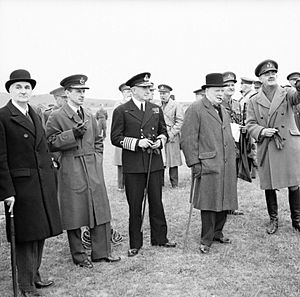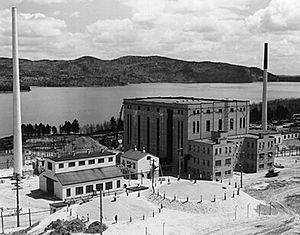Tube Alloys facts for kids
Tube Alloys was the secret project started by the United Kingdom, with help from Canada, to create nuclear weapons during World War II. This project began even before the Manhattan Project in the United States. The British efforts were kept highly secret, so they used a special code name, "Tube Alloys," even among top government officials.
Scientists quickly realized that powerful nuclear weapons might be possible during the war. At the University of Birmingham, two scientists, Rudolf Peierls and Otto Robert Frisch, wrote a paper. It explained that a small amount of pure uranium-235 could create a huge chain reaction in a bomb. This bomb could be as powerful as thousands of tons of TNT. This discovery led to the creation of the MAUD Committee. This committee pushed for a full effort to build nuclear weapons. Wallace Akers, who led the project, chose the misleading code name "Tube Alloys." His team was part of the Department of Scientific and Industrial Research.
The Tube Alloys program in Britain and Canada was the first project to develop nuclear weapons. Building these weapons was very expensive. Also, Britain was fighting a war and was within reach of enemy bombers. Because of these reasons, the Tube Alloys project eventually joined forces with the American Manhattan Project. This happened through the Quebec Agreement. Under this agreement, the two countries agreed to share nuclear weapon technology. They also promised not to use these weapons against each other or other countries without mutual agreement. However, the United States did not share all the details of the Manhattan Project with the UK. The Soviet Union learned important secrets through its atomic spies, who had found ways into both the British and American projects.
After the war, the United States stopped sharing information. This was due to the Atomic Energy Act of 1946. This made the United Kingdom restart its own project, called High Explosive Research. New factories were built, and British scientists continued their work on their own. Finally, in 1952, Britain tested its first nuclear bomb. This test was called "Operation Hurricane". Later, in 1958, after the Sputnik crisis and Britain showing it had a powerful thermonuclear bomb, the UK and the US signed the US–UK Mutual Defence Agreement. This agreement brought back the close nuclear partnership between Britain and the United States.
Contents
How Nuclear Power Was Discovered
The Discovery of Fission
In February 1932, James Chadwick discovered the neutron at the University of Cambridge. A few months later, his colleagues John Cockcroft and Ernest Walton split lithium atoms using accelerated protons. Later, Enrico Fermi and his team in Rome experimented by hitting elements with slow neutrons. This created heavier elements and isotopes.
Then, in December 1938, Otto Hahn and Fritz Strassmann in Berlin-Dahlem hit uranium with slow neutrons. They found that barium was produced. This meant the uranium atomic nucleus had been split! Hahn wrote to his colleague Lise Meitner. She and her nephew Otto Robert Frisch then explained why this happened. They published their findings in the science journal Nature in 1939. This splitting of the atom was a new type of nuclear reaction, much more powerful than anything seen before. Frisch and Meitner calculated that each split released a huge amount of energy. They called this process "fission", like how biological cells divide.
The Paris Group's Discoveries
A group of scientists in Paris, including Frédéric Joliot-Curie, Hans von Halban, Lew Kowarski, and Francis Perrin, followed up on this discovery. In February 1939, they showed that when uranium fissions, it releases two or three extra neutrons. This was a very important observation. It suggested that a self-sustaining nuclear chain reaction might be possible.
The idea of an "atomic bomb" was already known to the British public from a 1913 novel by H. G. Wells. Many scientists quickly realized that, in theory, an incredibly powerful explosive could be made. However, most still thought an atomic bomb was impossible. Perrin defined a critical mass of uranium. This is the smallest amount that can keep a chain reaction going. The neutrons that cause fission in uranium are slow. But when neutrons are released during fission, they are fast. So, to keep a chain reaction going, a neutron moderator was needed. This would slow down the fast neutrons until they had the right energy. The Paris Group found that both water and graphite could work as moderators.
In early 1940, the Paris Group decided that heavy water would be the best moderator. They asked the French Minister of Armaments to get as much heavy water as possible. The only place to get it was the large Norsk Hydro power station in Norway. The French found out that Germany had already tried to buy all the heavy water in Norway. This suggested Germany might also be working on an atomic bomb. The French told the Norwegian government how important heavy water could be for military use. Norway gave its entire supply of 187 litres (41 imp gal; 49 US gal) to a French agent. He secretly brought it to France just before Germany invaded Norway in April 1940. On 19 June 1940, after Germany invaded France, the heavy water was shipped to England. It was first kept at HM Prison Wormwood Scrubs and later secretly stored in the library at Windsor Castle. The Paris Group scientists moved to Cambridge, England, except for Joliot-Curie, who stayed in France and joined the French Resistance.
The Frisch–Peierls Memorandum
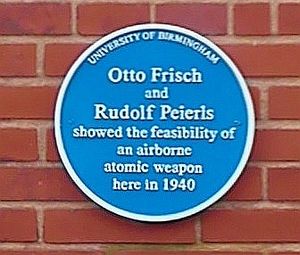
In Britain, several scientists wondered if an atomic bomb was truly possible. At the University of Liverpool, Chadwick and Joseph Rotblat worked on the problem, but their calculations weren't clear. At Cambridge, Nobel Prize winners George Paget Thomson and William Lawrence Bragg wanted the government to quickly get uranium ore. The main source was the Belgian Congo, and they worried it might fall into German hands.
They spoke to Sir William Spens, who contacted a Member of Parliament, Sir Kenneth Pickthorn. He then took their concerns to Major General Hastings Ismay. Ismay asked Sir Henry Tizard for his opinion. Like many scientists, Tizard doubted an atomic bomb could be made, thinking the chances were 100,000 to 1.
Even with such low odds, the danger was serious enough to be taken seriously. Lord Chatfield found that the Belgian Congo uranium was owned by a company called Union Minière du Haut Katanga. Its British vice president, Lord Stonehaven, arranged a meeting with the company's president, Edgar Sengier. Since the company was friendly with Britain, they didn't immediately buy the uranium. Instead, Tizard's committee was told to keep researching atomic bombs. Thomson at Imperial College London and Mark Oliphant at the University of Birmingham were asked to do experiments on uranium. By February 1940, Thomson's team had failed to create a chain reaction in natural uranium and stopped their work.
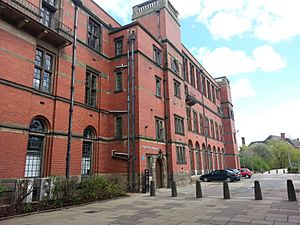
At Birmingham, Oliphant's team reached a different conclusion. Oliphant gave the task to two German refugee scientists, Rudolf Peierls and Otto Frisch. They couldn't work on Oliphant's radar project because they were considered "enemy aliens" and didn't have the necessary security clearance. Francis Perrin had calculated the critical mass of uranium to be about 40 tons (44 short tons). He thought that if a neutron reflector was placed around it, this might be reduced to 12 tons (13 short tons). Peierls tried to make the problem simpler by using the fast neutrons produced by fission, so he didn't need to consider a moderator. He also calculated the critical mass of a uranium sphere in a 1939 paper to be "of the order of tons."
Peierls understood how important the size of the critical mass was for a chain reaction to happen. Inside a critical mass, neutrons are naturally produced by the material that can fission. A very small part of these neutrons hit other nuclei, while a larger part escape through the surface. Peierls calculated the balance where the number of neutrons produced equaled the number escaping.
Niels Bohr had suggested that the rare uranium-235 isotope, which makes up only about 0.7% of natural uranium, was mainly responsible for fission with fast neutrons. This idea was not yet fully accepted. Frisch and Peierls were able to update their first guess for the critical mass needed for nuclear fission in uranium. They found it was much less than thought before. They estimated that a metal sphere of uranium-235 with a radius of 2.1 centimetres (0.83 in) would be enough. This amount was about 1 kilogram (2.2 lb) of uranium-235. These findings led to the Frisch–Peierls memorandum. This was the first step in Britain's nuclear weapons program. It marked the start of serious work to separate uranium isotopes and build an atomic bomb.
Oliphant took their findings to Tizard. Tizard then passed them to Thomson, who was in charge of uranium research. After discussions, a new group called the MAUD Committee was formed to investigate further.
The MAUD Committee
The MAUD Committee was created in June 1940. It was first part of a larger committee but later became independent. The committee was initially named after its chairman, Thomson. But it quickly changed to a more secret name, the MAUD Committee. The name MAUD came from a strange telegram Niels Bohr sent to Frisch after Germany invaded Denmark. The telegram ended with "Tell Cockcroft and Maud Ray Kent." At first, they thought it was a secret code about radium. But when Bohr returned to England in 1943, they found out it was a message for Bohr's housekeeper, Maud Ray, and Cockcroft. Maud Ray was from Kent. So, the committee was named The MAUD Committee, with the capital letters showing it was a code name, not an acronym. Meetings were usually held at the Royal Society in London. Its first members included Thomson, Chadwick, Cockcroft, Oliphant, Philip Moon, Patrick Blackett, Charles Ellis, and Norman Haworth.
Four universities were involved in the experiments. The University of Birmingham laboratory, led by Peierls with help from Klaus Fuchs, handled all the theoretical work. This included figuring out the critical mass needed for an explosion. The laboratories at the University of Liverpool and the University of Oxford experimented with different ways to separate isotopes. Chadwick's group at Liverpool worked on thermal diffusion. This method uses the idea that different uranium isotopes move at different speeds. Franz Simon's group at Oxford studied gaseous diffusion of isotopes. This method uses the idea that at different pressures, uranium-235 would pass through a barrier faster than uranium-238. Gaseous diffusion eventually became the most promising way to separate the isotopes. Egon Bretscher and Norman Feather's group at Cambridge looked into whether another element, now called plutonium, could be used as an explosive. Thanks to the French scientists, Oxford also had the world's only supply of heavy water. This helped them understand how uranium could be used for power.
The MAUD Committee's research was put into two reports in July 1941, known as the MAUD reports. The first report, "Use of Uranium for a Bomb," said that creating a super-bomb from uranium was possible. The second, "Use of Uranium as a Source of Power," discussed using uranium for energy, not just for a bomb. The MAUD Committee and its reports helped start the British nuclear program, the Tube Alloys Project. It also helped kick-start the American project. Without the MAUD Committee, the American program, the Manhattan Project, would have started months later. Instead, they could begin thinking about how to build a bomb, not just if it was possible. Historian Margaret Gowing noted that "events that change a time scale by only a few months can nevertheless change history."
The MAUD reports were reviewed by a special panel. This panel was chaired by Lord Hankey. The panel met seven times in September 1941 and gave its report to Sir John Anderson. At this time, there was a fear that German scientists were trying to build an atomic bomb for their country. So, Britain felt it needed to finish its own first. The report said that if there was even a small chance the bomb could be made, Britain should do everything possible to make sure it didn't fall behind. It suggested building a small separation plant in Britain, but the main production factory should be in Canada. The panel submitted its report on 24 September 1941. But by then, the final decision had already been made. Lord Cherwell had spoken to Prime Minister Winston Churchill. Churchill became the first national leader to approve a nuclear weapons program on 30 August 1941. The military leaders also supported the decision.
The Tube Alloys Program
How the Project Was Organized
A special group called the Tube Alloys directorate was set up. It was part of Sir Edward Appleton's Department of Scientific and Industrial Research. Wallace Akers, a research director from Imperial Chemical Industries (ICI), was chosen to lead it. Anderson and Akers came up with the name Tube Alloys. It was chosen to sound meaningless, "with a specious air of probability about it," meaning it sounded like a real project but gave no clues about what it was.
An advisory committee, the Tube Alloys Consultative Council, was created to oversee the work. Anderson chaired it, and its members included Lord Hankey, Lord Cherwell, Sir Edward Appleton, and Sir Henry Dale. This group handled the main plans. For technical issues, a Technical Committee was formed. Akers was its chairman. Its first members were Chadwick, Simon, Halban, Peierls, and Roland Edgar Slade from ICI. Michael Perrin was its secretary. Later, Charles Galton Darwin, Cockcroft, Oliphant, and Feather also joined.
Separating Isotopes
The biggest challenge for the MAUD Committee was to separate the tiny amount of uranium-235 (0.7%) from the much larger amount of uranium-238 (99.3%). This is hard because both types of uranium are chemically the same. The separation, called uranium enrichment, had to be done on a very large scale.
At Cambridge, Eric Rideal and his team looked into using a gas centrifuge. Frisch chose to try gaseous thermal diffusion using special tubes called Clusius tubes because it seemed the simplest method. Frisch's calculations showed that 100,000 Clusius tubes would be needed to get the right amount of separation. Peierls then turned to Franz Simon, who wanted to find a method that could be mass-produced more easily.

When Moon presented the idea of gaseous thermal diffusion to the MAUD committee, they didn't agree to move forward with it. The committee talked with Peierls and Simon about separation methods. They decided that "ordinary" gaseous diffusion was the best way to go. This method uses Graham's Law, which states that gases spread through tiny holes at speeds based on their weight. Francis William Aston used this method in 1913 to separate two isotopes of neon by passing a sample through clay thousands of times. However, thick materials like clay were too slow for industrial use. Simon suggested using a metal foil with millions of tiny holes. This would make the separation process much faster. He estimated that a factory to separate 1 kilogram (2.2 lb) of uranium-235 from natural uranium per day would cost about £5,000,000 to build. It would cost £1,500,000 per year to run, and use £2,000,000 worth of uranium and other materials. The MAUD Committee realized that an atomic bomb was not only possible but likely to be built.
In 1941, Frisch moved to London to work with Chadwick. Frisch built a Clusius tube there to study uranium hexafluoride. Frisch and Chadwick found that the Clusius method wouldn't work for this gas. This was a small problem because Simon was already working on the alternative method of separation using ordinary gaseous diffusion.
The chemical challenges of making gaseous uranium compounds and pure uranium metal were studied at the University of Birmingham and by ICI. Michael Clapham did early experiments with uranium production. Philip Baxter from ICI, who knew about fluorine compounds, made the first small batch of gaseous uranium hexafluoride for Chadwick in 1940. ICI received a formal contract for £5,000 in December 1940 to make 3 kilograms (6.6 lb) of this important material. The first gaseous diffusion equipment was made by Metropolitan-Vickers (MetroVick) in Manchester. It cost £150,000 for four units. These units were set up at the M. S. Factory in a valley near Rhydymwyn, in Wales. M. S. stood for the Ministry of Supply. The building used was called P6, and test equipment was installed there. A team of about seventy people, led by Peierls and Fuchs, tested these units. The results of these tests led to the building of the gaseous diffusion factory at Capenhurst, Cheshire. ICI also started pilot plants in Widnes in mid-1943. These plants produced 1 long hundredweight (51 kg) of pure uranium metal and 50 to 100 kilograms (110 to 220 lb) of uranium hexafluoride per day.
The Discovery of Plutonium
The big discovery about plutonium came from Bretscher and Norman Feather at the Cavendish Laboratory. They realized that a nuclear reactor using slow neutrons and uranium fuel would create a lot of plutonium-239 as a side product. This happens because uranium-238 absorbs slow neutrons and changes into a new, short-lived isotope, uranium-239. This new isotope quickly releases an electron through beta decay, forming a new element with an atomic mass of 239 and an atomic number of 93. This element then also releases an electron, becoming another new element with atomic number 94 and a much longer life. Bretscher and Feather showed that element 94 would be fissile (easily split by both slow and fast neutrons). Plus, it would be chemically different from uranium, making it easier to separate.
This new idea was also confirmed by Edwin M. McMillan and Philip Abelson at Berkeley Radiation Laboratory in 1940. Nicholas Kemmer of the Cambridge team suggested naming the new element 93 neptunium and element 94 plutonium. These names were chosen because they are like the outer planets Neptune and Pluto, which are beyond Uranus (uranium is element 92). The Americans also happened to suggest the same names. The first sample of plutonium was made and identified in 1941. This is usually credited to Glenn Seaborg, who used a cyclotron at the University of California instead of a reactor. In 1941, neither team knew about the other's work.
Chadwick worried about how pure plutonium needed to be for a working bomb. He also thought that the "gun method" for setting off a plutonium bomb might cause it to explode too early because of impurities. After Chadwick met Robert Oppenheimer at the Los Alamos Laboratory in 1943, he learned about a new bomb design called "implosion." In this design, a small, non-critical amount of plutonium would be surrounded by explosives. These explosives would be set off at the same time, squeezing the plutonium core. This compression would make the plutonium become critical and explode. The core would be surrounded by a depleted uranium tamper. This tamper would reflect neutrons back into the reaction and also add to the explosion by fissioning itself. This design solved Chadwick's worries about purity because it didn't need the same high level of purity as the gun-type fission weapon. The biggest challenge with this method was creating the special explosive lenses. Chadwick took this information and described the method to Oliphant, who then brought it to England.
The Montreal Laboratory
Halban's heavy water team from France continued their slow neutron research at Cambridge University. However, this project was not seen as important for making bombs, so it was given low priority. It suddenly became very important when scientists realized it could lead to plutonium. The British Government wanted the Cambridge team to move to North America. This would put them closer to the raw materials they needed and where American research was happening. But Sir John Anderson wanted the British team to keep its own identity. He was also worried that since the Americans were working on nuclear reactor designs using nuclear graphite instead of heavy water, the British team might not get enough resources.
The Americans had their own concerns, especially about security. Only one of the six main scientists in the British group was actually British. They also worried about patent rights, fearing the French team might try to patent nuclear technology based on their pre-war work. As a compromise, Thomson suggested moving the team to Canada.
The Canadian government was asked, and Jack Mackenzie, the president of the National Research Council of Canada, quickly welcomed the idea. The costs and salaries would be split between the British and Canadian governments. The British share would come from a billion-dollar war gift from Canada. The first eight staff members arrived in Montreal at the end of 1942. They worked in a house belonging to McGill University. Three months later, they moved into a 200 square metres (2,200 sq ft) area in a new building at the University of Montreal. The laboratory quickly grew to over 300 staff. About half were Canadians recruited by George Laurence. A group of scientists who focused on theories was recruited and led by George Placzek, a Czechoslovak physicist. Placzek was a very good leader. He was seen as the only staff member with top scientific skills and close connections to many important physicists in the Manhattan Project. Friedrich Paneth became head of the chemistry division, and Pierre Auger led the experimental physics division. Von Halban was the director of the laboratory, but he was not a good manager and didn't work well with the National Research Council of Canada. The Americans saw him as a security risk and didn't like the French atomic patents claimed by the Paris Group.
Niels Bohr's Help
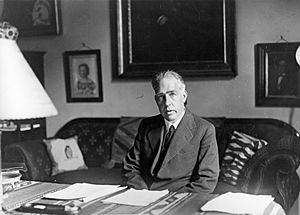
Sir John Anderson really wanted Niels Bohr to join the Tube Alloys project. Bohr was a world-famous scientist. He would not only bring his knowledge to the project but also help the British government in its dealings with the Manhattan Project.
In September 1943, Bohr in Denmark heard that the Nazis considered his family Jewish and that they were in danger of being arrested. The Danish resistance helped Bohr and his wife escape by sea to Sweden on 29 September 1943. When Britain heard about Bohr's escape, Lord Cherwell sent a telegram asking Bohr to come to Britain. Bohr arrived in Scotland on 6 October, flying in a special plane.
At the invitation of Brigadier General Leslie R. Groves Jr., the director of the Manhattan Project, Bohr visited the American project sites in November 1943. Groves offered Bohr a lot of money, but Bohr first refused. He wanted to make sure the relationship between the United States and Great Britain remained a true partnership. In December 1943, after meeting with Albert Einstein, Bohr and his son Aage agreed to work on the Manhattan Project. Bohr made a big contribution to the atomic bomb effort. He also tried to stop a nuclear arms race with the Soviet Union after the war, which he thought was a serious danger. In 1944, Bohr shared some key ideas he believed were important for controlling nuclear weapons around the world. He urged Britain and the United States to tell the Soviet Union about the Manhattan Project. He thought this would make the Soviets less likely to feel threatened and start building their own bomb in secret. He believed the Russians already knew about the project, so there was no point in hiding it.
Bohr's belief came from a letter he received from a Soviet scientist friend in Russia. He showed this letter to the British security services. He thought that the longer the United States and Britain kept their nuclear progress secret, the more threatened the Russians would feel. This would make them speed up their own efforts to build an atomic bomb. With help from U.S. Supreme Court justice Felix Frankfurter, Bohr met with President Franklin D. Roosevelt on 26 August 1944. Roosevelt was initially open to Bohr's ideas about controlling nuclear weapons. But Churchill was strongly against telling the Soviet Union about the work. At the Second Quebec Conference in September 1944, Roosevelt agreed with Churchill. They decided it was best to keep the atomic bomb project a secret. They also thought Bohr might be dangerous and that security measures should be taken to stop him from sharing information with the world, especially Russia.
Tube Alloys in the United States
The Tizard Mission
In August 1940, a British group, led by Tizard and including Cockcroft, was sent to America. Their goal was to build relationships and help advance war technology with the Americans. They shared several military technologies, such as improvements in radar, anti-submarine warfare, aircraft engineering, and explosives. The American radar program especially got a boost, leading to new developments in microwave radar and proximity fuzes. This led the Americans to create the MIT Radiation Laboratory, which later became a model for the Los Alamos Laboratory. The mission didn't spend much time on nuclear fission, with only two meetings on the topic, mainly about uranium enrichment. Cockcroft, for example, didn't share Peierls' and Frisch's findings. Still, there were important results. A barrier was broken, and a way to share technical information between the two countries was created. Also, the idea that civilian scientists could play a big role in developing military technologies became stronger in both countries.
Oliphant's Visit to the United States
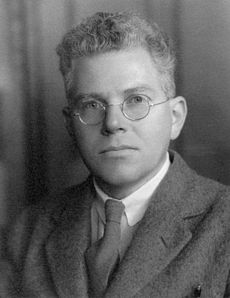
The MAUD Committee reports strongly urged continued cooperation with the United States on nuclear fission research. Charles C. Lauritsen, a physicist from Caltech working for the National Defense Research Committee (NDRC), was in London at this time. He was invited to attend a MAUD meeting. The committee pushed for quickly developing nuclear weapons using gaseous diffusion to separate isotopes. When he returned to the United States, he told Vannevar Bush, the director of the Office of Scientific Research and Development (OSRD), about the details discussed at the meeting.
In August 1941, Mark Oliphant, who was the head of the physics department at the University of Birmingham and an original member of the MAUD Committee, was sent to the US to help the NDRC with radar. During his visit, he met with William D. Coolidge. Coolidge was shocked when Oliphant told him that the British had predicted that only ten kilograms (22 lb) of uranium-235 would be enough to create a chain reaction using fast neutrons. While in America, Oliphant found out that the chairman of the OSRD S-1 Section, Lyman Briggs, had kept the MAUD reports from Britain locked away. He had not told the S-1 Committee members about all their findings.
Oliphant decided to tell the US scientific community himself about the important discoveries the MAUD Committee had made. Oliphant also traveled to Berkeley to meet with Ernest Lawrence, who invented the cyclotron. After Oliphant told Lawrence about his report on uranium, Lawrence met with other important scientists to share the details Oliphant had given him. Oliphant not only contacted Lawrence but also met with Bush to inform them of the significant data the MAUD had found. Oliphant's actions led to him convincing Lawrence, Lawrence convincing Compton, and then George Kistiakowsky convincing Conant to move forward with nuclear weapons. These efforts by Oliphant resulted in Bush taking this report directly to the president.
Sharing Information Stops
The American effort grew quickly and soon became much larger than the British one. The American authorities were not keen to share details with their British partners. However, separate research continued in each country with some exchange of information. Several key British scientists visited the United States in early 1942 and were given full access to all available information. They were amazed at how fast the American atomic bomb project was moving. The British and American exchange of information and efforts continued, but the nations did not combine their efforts, working on their programs separately. Also, in 1941, the British Government rejected attempts by Bush and Conant to increase cooperation between Britain and America.
In June 1942, the United States Army Corps of Engineers took over the Manhattan Project from OSRD, and Groves became its director. He made security much tighter, which reduced the flow of information to Britain. American officials were especially worried that Akers and other people from ICI involved in Tube Alloys were trying to use American nuclear science to create a profitable industry after the war. In October 1942, Bush and Conant convinced Roosevelt that the United States should develop the atomic bomb project on its own, even though there was an agreement to share scientific information freely between the US and Britain.
This greatly hurt British efforts because they lacked enough people, facilities, equipment, and materials. Tube Alloys, therefore, fell behind the Manhattan Project. On 30 July 1942, Anderson told Churchill: "We must face the fact that... [our] pioneering work... is becoming less valuable and that, unless we use it quickly, we will be surpassed. We now have a real contribution to make to a 'merger.' Soon we will have little or none." By the time Britain realized this, the situation had gotten worse. Bush decided that outside help for the Manhattan Project was no longer needed. The Military Policy Committee (MPC) agreed with Bush and limited access to secret information that Britain could use for its atomic weapons program, even if it slowed down American efforts.
The Americans stopped sharing any information about heavy water production, the method of electromagnetic separation, the properties of plutonium, details of bomb design, or facts about fast neutron reactions. This was a big disappointment that held back the British and Canadians, who were working together on heavy water production and other parts of the research. By 1943, Britain had stopped sending its scientists to the United States. This slowed down the work there, which had relied on efforts led by British scientists. In March 1943, Conant spoke to the Military Policy Committee, which decided that Britain's help would benefit some areas of the project. Chadwick, William Penney, Peierls, Oliphant, and other British scientists were important enough that the bomb design team at the Los Alamos Laboratory needed them, even with the risk of revealing weapon design secrets.
The Quebec Agreement
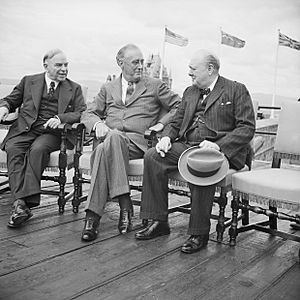
Churchill looked into building Britain's own gaseous diffusion plant, a heavy water plant, and an atomic reactor in Britain, despite the huge cost. A gaseous diffusion plant to produce a kilogram (2.2 lb) of weapons-grade uranium per day was estimated to cost up to £3 million for research and development. Building it in wartime Britain could cost up to £50 million. A nuclear reactor to produce that much plutonium per day would have to be built in Canada. It would take up to five years to build and cost £5 million. The project would also need facilities to produce the required heavy water (between £5 million and £10 million) and uranium metal (£1.5 million). The project would need top priority. It was estimated to require twenty thousand workers, many of them highly skilled, half a million tons of steel, and a huge amount of electricity. This would definitely disrupt other wartime projects, and it was unlikely to be ready in time to affect the outcome of the war in Europe. Everyone agreed that they should first try again to get American cooperation.
In July 1943, in London, American officials cleared up some big misunderstandings about British reasons. After many months of talks, the Quebec Agreement was signed by Churchill and Roosevelt on 19 August 1943 during the Quebec Conference. The British gave their materials to the Americans and, in return, received copies of the American progress reports to the President. Tube Alloys became part of the Manhattan Project. In a section of the Quebec Agreement, Britain and the USA agreed to share resources "to bring the Tube Alloys project to fruition at the earliest moment." The leaders also agreed that:
- "First, we will never use this agency against each other,
- Secondly, we will not use it against third parties without each other's consent, and
- Thirdly, we will not either of us communicate any information about Tube Alloys to third parties except by mutual consent."
It was also agreed that any benefits after the war, like industrial or commercial ones, would be decided by the President. The Quebec Agreement created the Combined Policy Committee to control the Manhattan Project. This committee included Henry Stimson, Bush, and Conant from the United States; Field Marshal Sir John Dill and Colonel J. J. Llewellin were the British members, and C. D. Howe was the Canadian member. Llewellin returned to the United Kingdom at the end of 1943 and was replaced by Sir Ronald Ian Campbell, who was later replaced by the British Ambassador to the United States, Lord Halifax, in early 1945. Dill died in Washington, D.C., in November 1944 and was replaced by Field Marshal Sir Henry Maitland Wilson. The later Hyde Park Agreement on 19 September 1944 extended this cooperation to the time after the war.
Britain's Help to the Manhattan Project
Akers called Chadwick, Oliphant, Simon, and Peierls to the United States. They arrived the day the Quebec Agreement was signed, ready to help the Manhattan Project. Akers was generally not well-liked, and the Americans refused to move forward with working together unless a top British scientist who was "accepted and sound of judgement" was appointed instead. British officials insisted on Britain's right to choose its own people for its government agencies. A compromise was reached: Chadwick was put in charge as Britain's technical advisor for the Combined Policy Committee and as the head of the British Mission to the Manhattan Project.

With this disagreement settled, cooperation could begin again. Chadwick wanted to involve as many British scientists as possible, as long as Groves approved them. Chadwick's first choice, Joseph Rotblat, refused to give up his Polish citizenship. Chadwick then turned to Otto Frisch, who, to Chadwick's surprise, immediately agreed to become a British citizen and started the process to travel to America. Chadwick spent the first few weeks of November 1943 getting a clear understanding of the huge Manhattan Project. He realized the scale of places like Oak Ridge, Tennessee, which was the project's new headquarters. He could confidently conclude that without a similar industrial site in Germany, the chances of the Nazi atomic bomb project succeeding were very low.
With Chadwick involved, the main goal was to show that the Quebec Agreement was a success. It was Britain's duty to cooperate fully and speed up the process. Chadwick used this chance to give as many young British scientists as possible experience. This way, they could bring that experience back to Britain after the war. He eventually convinced Groves that Rotblat was trustworthy, and Rotblat was accepted into the Manhattan Project without giving up his nationality. Rotblat had been left in charge of the Tube Alloys research and brought with him the results obtained since Chadwick had left.
The Montreal team in Canada relied on the Americans for heavy water from the US heavy water plant in Trail, British Columbia, and for technical information about plutonium. The Americans said they would supply heavy water to the Montreal group only if it agreed to focus its research on the limited areas suggested by DuPont, their main contractor for reactor building. Despite doing good work, by June 1943, the Montreal Laboratory had completely stopped. Morale was low, and the Canadian Government suggested canceling the project. In April 1944, a Combined Policy Committee meeting in Washington agreed that Canada would build a heavy water reactor. The Americans agreed to support the project with information, visits, and to supply materials, including important uranium and heavy water. The Montreal Laboratory would get access to data from the Metallurgical Laboratory's research reactors at Argonne and the X-10 Graphite Reactor at Oak Ridge. However, it would not get any information from the production reactors at the Hanford Site. Also, it would not be given any information about the chemistry of plutonium or how to separate it from other elements. This agreement was formally approved by the Combined Policy Committee on 19 September 1944. John Cockcroft became the director of the Montreal Laboratory. The Chalk River Laboratories opened in 1944, and in 1946, the Montreal Laboratory was closed. The project developed the ZEEP reactor, which started working in September 1945.
William Penney, one of the Tube Alloys scientists, was an expert in shock waves. In June 1944, he went to America to work at the Los Alamos Laboratory as part of the British team. He worked on how to figure out the effects of a nuclear explosion. He wrote a paper on what height the bombs should be set off for the biggest effect in attacks on Germany and Japan. He was part of the target committee that Groves set up to choose Japanese cities for atomic bombing. He also worked on Tinian with Project Alberta as a special consultant. Along with Group Captain Leonard Cheshire, who was a British representative, he watched the bombing of Nagasaki from the observation plane Big Stink. He also joined the Manhattan Project's team that went to Hiroshima and Nagasaki after the war to see how much damage the bombs had caused.
The Smyth Report was released by the US War Department on 12 August 1945. It told the story of the atomic bomb and included technical details that could now be made public. It mentioned little about the British contribution to the bomb. A White Paper, Statements Relating to the Atomic Bomb, was quickly written by Michael Perrin. This report was released just after Clement Attlee became Prime Minister, replacing Churchill. It was the only official statement on the British contribution for fifteen years.
After the War
Soviet Spies in the Tube Alloys Project
The Soviet Union received secret details about British research from its atomic spies. These included Klaus Fuchs, Engelbert Broda, Melita Norwood, and John Cairncross, who was part of the famous Cambridge Five spy ring. Alan Nunn May was recruited later in Canada. A report from Lavrenty Beria to Stalin in March 1942 included the MAUD reports and other British documents passed by Cairncross.
Fuchs began sharing information with the Soviet Union about a possible British atomic bomb when he joined the Tube Alloys project. However, his help to Soviet spying was more significant during the Manhattan Project. Fuchs was able to contact a leader of the KPD in London, Jürgen Kuczynski. Kuczynski connected him with Simon Davidovitch Kremer, who worked for the GRU (Russian military intelligence). After three meetings, Fuchs was paired with a courier so he wouldn't have to find excuses to travel to London. This courier was Ursula Kuczynski, Jürgen Kuczynski's sister. She was also a German communist, a major in Soviet Military Intelligence, and an experienced agent who had worked with Richard Sorge's spy ring in the Far East.
Post-War Developments
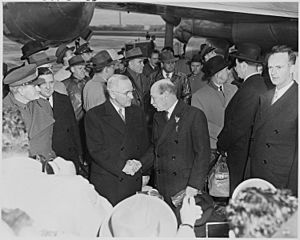
After the war ended, the close relationship between Britain and the United States "became very much less special." Roosevelt died on 12 April 1945, and the Hyde Park Agreement was not binding on future leaders. In fact, the agreement was physically lost. When Wilson brought it up in a meeting in June, the American copy couldn't be found. The British sent Stimson a photocopy on 18 July 1945. Even then, Groves questioned if the document was real until the American copy was found years later. It had been misfiled by someone who didn't know what Tube Alloys was and thought it had something to do with naval guns.
The British government had trusted that America would share nuclear technology, which the British saw as a joint discovery. On 9 November 1945, Mackenzie King and Prime Minister Clement Attlee went to Washington, D.C. They met with President Harry Truman to talk about future cooperation on nuclear weapons and nuclear power. The three leaders agreed there would be full and effective cooperation on atomic energy. However, British hopes for a full return to cooperation on nuclear weapons were not met. The Americans soon made it clear that this cooperation was only for basic scientific research.
The Atomic Energy Act of 1946 (the McMahon Act), passed in August 1946, made it clear that the UK would no longer be allowed to access the United States' atomic research. This partly happened because Alan Nunn May was arrested for spying in February 1946. On 8 January 1947, Attlee formed a secret committee. This committee decided that Britain needed the atomic bomb to keep its important place in world politics. As Foreign Secretary Ernest Bevin said, "That won't do at all... we've got to have this... I don't mind for myself, but I don't want any other Foreign Secretary of this country to be talked to or at by a Secretary of State in the United States as I have just had in my discussions with Mr Byrnes. We've got to have this thing over here whatever it costs... We've got to have the bloody Union Jack on top of it."
Marshal of the Royal Air Force Lord Portal was chosen to lead the effort, code-named High Explosive Research. The Atomic Energy Research Establishment (AERE) near Harwell, Oxfordshire, was created by Cockcroft in 1946. It became the main center for military and civilian atomic energy research and development. Penney led the bomb design effort. He was Chief Superintendent Armament Research (CSAR), in charge of the Ministry Of Supply's Armaments Research Department (ARD) at Fort Halstead in Kent and the Royal Arsenal at Woolwich. In April 1950, an old Second World War airfield, RAF Aldermaston in Berkshire, was chosen as the permanent home for what became the Atomic Weapons Research Establishment (AWRE). Penney put together a team to start the work. First, they wrote a report describing the features, science, and ideas behind the American Fat Man implosion-type nuclear weapon. He broke down the development tasks needed to copy it, identifying questions that needed more research on nuclear weapons.
On 3 October 1952, under the code-name "Operation Hurricane", the first British nuclear device was successfully set off in the Monte Bello Islands off the west coast of Australia. The Sputnik crisis and the development of the British hydrogen bomb led to changes in the Atomic Energy Act in 1958. This resulted in the nuclear partnership between America and Britain starting again under the 1958 US–UK Mutual Defence Agreement.


